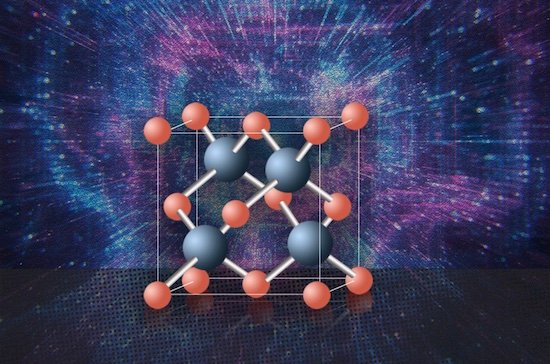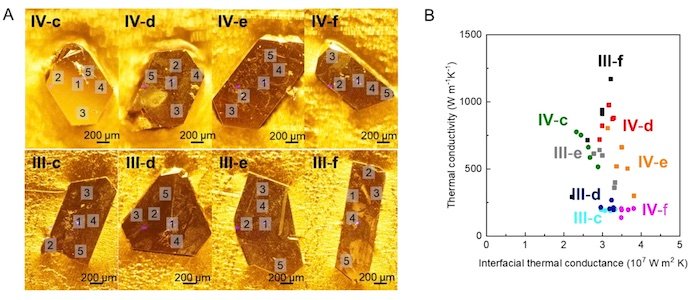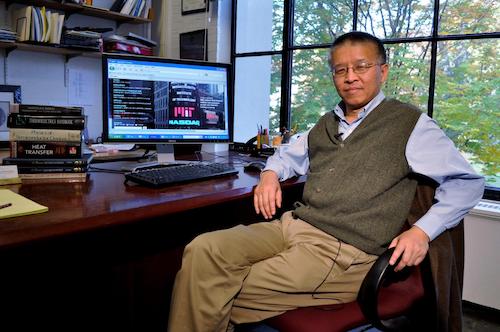Several parameters indicate what makes a good semiconductor but to call one “the “best,” it needs to hit more indicators than the runner-ups. The little-known semiconductor cubic boron arsenide (c-BAs) is the newest contender for the top place.

Atomic structure of c-BA. Image used courtesy of MIT and Christine Daniloff
Recently, seventeen researchers from MIT (Massachusetts Institute of Technology), the University of Houston, the University of Texas at Austin, and Boston College co-wrote a paper elaborating on the optical transient grating technique used to check theoretical calculations linked to the c-BAs semiconductor properties.
With that in mind, this article will take a look at what makes c-BAs unique and look into the main theorist behind this technology.
What Makes c-BAs Unique?
Overall, c-BA is a thermally-stable, chemically-inert semiconductor with a crystalline structure made from boron and arsenic atoms with lab-proven properties that surpass those of known widespread semiconductors.
Cubic BAs could fix one of the most challenging issues silicon chips have—poor thermal conductivity. This challenge is because most electronics nowadays often require bulky and expensive cooling systems.
Another unique property of boron arsenide semiconductors is their high ambipolar mobility. Ambipolar mobility (also called high carrier mobility) is the property of electrons and holes in a semiconductor material to respond with equal mobility to a charge made by an electric field.
The problem with low ambipolar mobility is that negatively charged electrons behave like distant free-floaters, while positively charged holes with a greater mass get a stronger gravitational pull from the nucleus. In contrast, the ideal semiconductor would have the properties in which both negatively and positively charged particles travel with less resistance.
Unpacking c-BA's Attributes and Features
Experimental measures gathered by the research team have shown thermal conductivity of 1200 watts per meter per Kelvin (W/m/K), and ambipolar mobility of 1600 centimeters squared per volt per second (cm2/V/s).
Including this study, another published in the same journal also predicts that due to the hot electron effect, the electron mobility in cubic boron arsenide could reach as high as 3,000 cm2/V/s. Additionally, boron arsenide has a good bandgap, which makes it suitable for different applications compared to silicon.
Overall, c-BAs semiconductors seem to beat the commercial winner, the readily available silicon. Eventually, it could potentially outperform the more heat-resistant silicon carbide (SiC), gallium nitride (GaN), gallium arsenide (GAs), and graphene.
Boron arsenide has a thermal conductivity that is ten times greater than silicon. Silicon and gallium arsenide have good electron mobility and poor hole mobility. Graphene has high carrier mobility, but its substrates are expensive.
In addition to heat dissipation, electrical transport, and bandgap properties, semiconductors must be commercially viable to be considered a strong candidate for application in next-gen electronics. They need to be made at scale and at a justifiable price to find their place high on the rank of best semiconductors. Fast and cheap hits the mark. At the moment, there is a lot more to be invested in purifying the c-BAs crystals to enhance their practicality. It could take decades to reach that point.

Example of (A) c-BA crystals used in MIT and others' experiment and (B) their thermal conductivity vs thermal conductance. Image used courtesy of Shin et al (supplementary materials PDF)
So far, the research team has managed to support the theoretical claims in lab conditions on small batches of boron arsenide. The lab-made semiconductor batches had unstable, scattered placement of "holes" and electrons, making the batch material an unlikely candidate for measuring mobility with high precision.
For the researchers to produce high-quality crystals with high carrier mobility and thermal conductivity, the crystalline structure needs lower ionized and neutral impurity concentrations. Future work on boron arsenide could bring more evidence on its superior properties' viability.
The Main Theorist and the Issues Behind c-BAs
The theoretical predictions about boron arsenide properties were made in 2018 by Gang Chen, a professor of Mechanical Engineering at MIT and a nanotechnologist, using quantum mechanical density functional calculations.
Interestingly, the name of the Chinese-born Professor Chen, with a long academic career at US universities, has been linked to spying; however, without proof, the allegations have later been removed.

Professor Gang Chen at his work desk. Image used courtesy of MIT MECHE
Aiming to preserve the intellectual property of scientific discoveries, the US has become increasingly cautious about giving free rein over key technologies to foreign researchers and manufacturers.
Restricting access to new technologies due to national security interests is nothing new. The latest announcement by the US Commerce Department's Bureau of Industry and Security (BIS) includes restrictions on exporting wide bandgap semiconductor (WBG) materials, including gallium oxide and diamond. Cubic boron arsenide can also be classified in this group. In addition, this includes certain technologies appropriate for sophisticated weaponry.
Electronic computer-aided design (ECAD) technology and pressure gain combustion (PGC) technology are part of the latest ban. ECAD is used for designing circuits and transistors for scaling 3 nm semiconductors with high data processing speeds and power efficiency. PGC technology has massive ground and aerospace potential.
The export ban is among the number of measures imposed on China to counteract the country's determination to acquire world leadership as a technological superpower.
China seems to be still far behind with WBGs, having reached 7 nm chips made with deep UV lithography. It is, nevertheless, vital to be observant of the progress of advanced semiconductors. The many problems with semiconductors at the moment hint at new restrictions and locking horns as far as essential national security is in question.
